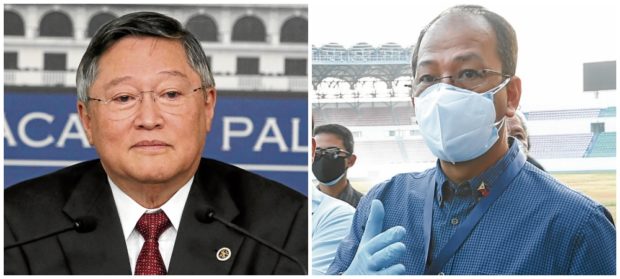The government is considering borrowing up to $9 billion (P433.3 billion) from the World Bank to help fund the country’s purchase of a potential COVID-19 vaccine as it starts negotiations with a leading pharmaceutical company for at least 3 million doses of the drug that will be given primarily to health workers.
Carlito Galvez Jr., COVID-19 national task force chief, said on Monday that the country would have to enter into “multilateral engagements with our credit partners,” such as the World Bank and the Asian Development Bank, since the allotted budget for the vaccine cannot be used to buy the drug in advance.
Galvez said Finance Secretary Carlos Dominguez III was already working on how much the government could borrow from the World Bank for the advance procurement of the vaccine.
‘A lot of funds’The government has set aside P10 billion and may get an additional P8 billion for vaccines, Galvez said. This is apart from the P25-billion standby fund for COVID-19 response under the Bayanihan to Recover as One Act, he said.
“Plus more or less the $5 to $9 billion that can be credited to our account, we already have allocated a lot of funds. This is why the President is very much confident that we already have the money, and he will still get more, for the vaccine,” Galvez said.
In September, the Department of Health (DOH) said some vaccine makers required advance payment for the Philippines to secure supplies. The procurement law, however, prohibits agencies from paying preordered items.
Galvez said the government was planning to buy an initial 50 million doses of a vaccine for 25 million Filipinos, mostly health workers and the elderly.
Earlier, British-Swedish drug maker AstraZeneca announced that if its large-scale Phase 3 clinical trials proved successful, it would ramp up manufacturing of its vaccine, which could be out in the market by January next year.
Galvez said the country’s vaccine expert panel gave AstraZeneca a “good evaluation,” but he did not provide details.
He, however, said the government had already met thrice with AstraZeneca and had been given assurance that the vaccine would be accessed by poor countries and sold at cost.
Of all the vaccines that have so far been evaluated by the panel, AstraZeneca’s is the cheapest at $5 per dose.
“Right now our negotiations [with AstraZeneca] are looking at accessing at least 3 to 5 million [doses]. But we’re working to [raise it to] at least 10 million doses for our [medical] front-liners,” he said.
Early 2022But Galvez sought to temper expectations, saying that despite these developments, there was a possibility that the bulk of the supplies needed by the country may not arrive till early 2022.
“As of this moment, if we can close negotiations within this year, there may be hope. Realistically, we may get 10 to 15 million [doses] between May and July,” he said.
Presidential spokesperson Harry Roque told a news briefing on Monday that the government hoped to be ready by March with its procurement processes, storage arrangements and early distribution plans for the vaccine.
Roque said the plans were based on a timeline submitted by Galvez.
He said the safety and efficacy of the vaccine must first be confirmed by the Food and Drug Administration and a panel of vaccine experts.
A decision must also be made whether to choose a vaccine administered in a single dose or two doses, as this would determine the type of cold storage that must be prepared.
It should also be decided if the vaccine must be procured from a single or multiple sources, Roque said.
He said the Department of Health (DOH), together with the national and local governments, would be in charge of implementing the nationwide vaccination program.
New infectionsOn Monday, the DOH logged 2,058 additional coronavirus infections, pushing the overall number of confirmed COVID-19 cases to 398,449.
Rizal province reported the most number of new infections, 103, followed by Davao City (81), Maguindanao (81), Quezon City (77) and Cavite (76).
Another 182 patients had recovered, bringing the total number of COVID-19 survivors to 361,784, the DOH said. The death toll, however, rose to 7,647 as 108 patients succumbed to the severe respiratory disease.
The recoveries and deaths left the country with 29,018 active cases, or 7.3 percent of the total, of which 82.7 percent were mild, 9.4 percent asymptomatic, 2.8 percent severe, and 5 percent critical. — WITH A REPORT FROM JEROME ANING INQ
